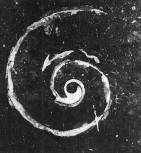
Figure 1
Maclurites sp., an Ordovician snail. (75 mm at largest diameter).
Photo by John Kelley
ABSTRACT - Black limestone floor tiles in the Maine State Capitol contain the fossilized remains of a variety of marine invertebrates. Fossiliferous limestone was first installed in the Capitol by the architect John C. Spofford during construction of the Capitol's west wing from 1889 to 1890. Additional fossil bearing limestone was installed by the architect G. Henri Desmond during an extensive remodeling and renovation of the original Capitol building from 1909 to 1911. |
“The years teach us much, which the days never knew.” -– Ralph Waldo Emerson 1844 |
This is the first report of fossils in the Maine State Capitol, but the fact that fossils can be found in building stones is neither new nor surprising. Stone has been used as a building material for thousands of years and there are many documented instances of fossiliferous building stones. The Egyptian pyramids, for example, were constructed of a limestone that is rich in fossilized Foraminifera, and many old buildings in Europe show the fossilized shells of ammonites and brachiopods (Matthews 1989). Floor stones in a Chicago museum contain occasional fossil cephalopods and the door arches in some of the oldest homes in Lyme Regis, England, are adorned with giant fossil ammonites (MacFall and Wollen 1983). The American Museum of Natural History and the Ohio Department of Natural Resources even offer walking tours of the fossils found in the churches, banks, courthouses and government buildings of New York and Cincinnati (Hannibal and Davis 1992; Steinmann 1978).
I first recognized the fossils in the State Capitol floors stones in 1992. After discussions with Walter Anderson, the State Geologist, he and staff from the Maine Geological Survey examined the stones and identified them as a carbonaceous limestone from the middle Ordovician Crown Point Formation at Isle La Motte, Vermont. That identification was based upon the composition of the stone and an initial survey revealing the presence of numerous specimens of Maclurites, a distinctive Ordovician snail-like mollusk abundant in the Crown Point Limestones of the Champlain Basin (Figure 1).

My subsequent survey of the State Capitol limestones has revealed the presence of at least four phyla of fossil marine invertebrates, all of which are consistent with fossil assemblages documented in the Chazy Group of limestone formations at Isle La Motte (Baldwin 1987; Erwin 1957; Welby 1962). No historical records have been found indicating exactly where the limestones of the State Capitol were quarried, but a review of its architectural history strongly supports the geologic and fossil evidence pointing to Isle La Motte as the origin of the stones. Richly fossiliferous "Radio Black" and "Champlain Black" limestone has been quarried at Isle La Motte since 1788 (Dale 1912) and has been used in such famous buildings as the RCA building and the Metropolitan Museum of Art in New York, the National Gallery of Art in Washington and the Borg Warner building in Chicago (Steinmann 1978). At the time the stones were being installed in the State Capitol, Isle La Motte was the largest and the nearest source of black architectural limestone and must have been well known to the large Boston architectural firms involved in the expansions and renovations of the Capitol.
Construction of the original State Capitol, designed by the famous architect Charles Bulfinch, was begun in 1829 on Weston Hill, a small knoll overlooking the Kennebec River in Augusta, Maine. Granite for the original structure was quarried in Hallowell and was hauled by oxen to the Weston Hill site. Since its completion in 1831, many of the details about the interior of the original building have been lost. It seems, however, that Bulfinch's original floors were made of wood (Leg. Doc. 1981; Shettleworth 1981).
Fossiliferous limestone was installed in the State Capitol floors on two occasions. The first of the fossil bearing stone was installed in 1889 and 1890 by the Boston architect John C. Spofford during the construction of the Capitol's west wing. In his design, Spofford (1889) specified the new wing be faced with "first quality, fine hammered Hallowell granite...that harmonizes with the present structure." Like Bulfinch, Spofford quarried his granite in Hallowell. Unlike Bulfinch, Spofford's floors were steel and terra cotta block arches covered with one inch thick white marble floor tiles. Probably for aesthetic reasons, to offset the white marbles, Spofford also chose to incorporate a "black marble" border into his floor design (Leg. Doc. 1891). As we now know, those border stones are not marble at all, but black limestones from Isle La Motte (Figure 2).
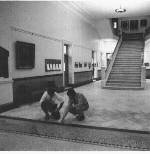
For twenty years following the completion of Spofford's addition, the floors of the State Capitol apparently remained a mixture of wood in the old part and marble in the newer west wing. Then, from 1909 and 1911, more fossiliferous limestone was installed by another Boston architect, G. Henri Desmond, during an extensive renovation and remodeling of the original Capitol. Desmond's work included the enlargement of the north and south wings to provide new chambers for the Senate and the House of Representatives, the replacement of the old central columns and the addition of a new, larger dome. Except for Spofford's west wing, which was generally not disturbed, most of the Capitol's exterior granite facing and all interior staircases, partitions and roofs, including the dome, were renovated. The old wooden floors, which were "a menace to life and a fire trap," were also removed (Desmond 1909; Leg. Doc. 1911). To unify the floors within the Capitol, Desmond required that "all the corridor floors above the lower one are of white marble with a colored marble base and border...to match the old work in every particular" (Desmond 1909).
Based on the fossil content of Desmond's stones, he matched the "old work" by returning to the same quarries that Spofford had relied upon nearly 20 years earlier. Those quarries had been active between 1890 and 1909, however, and a survey of the fossils in the stones installed by the two architects reveals that Desmond ended up with stone either from a different layer of the same quarry or from a Crown Point exposure in another, nearby quarry. Differences in the fossil content of the stones follow the exact line separating the work of the two architects and offer confirmation that the two sections of the floors were installed at different times. The stones in Spofford's west wing contain a rich variety of invertebrate fossils, but fossils in the stones installed by Desmond consist exclusively of the fragmented stalks of crinoids, animals similar to today's sea lilies.
The Class Crinoidea is one of five surviving classes of the Phylum Echinodermata, a large group with a long and complex fossil record dating back to the early Cambrian Period. The five-sided symmetry shared by all living and many extinct classes of echinoderms is clearly seen in the starfish (class Asteroidea) and sea urchins (class Echinoidea) common today along the coast of Maine. Although almost all living echinoderms are mobile, fossil crinoids such as those found in the State Capitol spent their adult lives fixed to the ocean bottom by long stalks.
The primitive stalked condition, predominant among crinoids during the Ordovician, is seen today only in the sea lilies, a small and relatively rare group of deep water crinoid species. Like the sea lilies, the stalks of these fossil crinoids were composed of hard plates, called columnals, which supported a flower-like crown consisting of a body cavity and branching arms that assisted in feeding. Because of their delicate form and a tendency for the individual stalk columnals to separate after the animal died, complete specimens of fossil crinoids are relatively rare. Individual columnals, however, were often preserved. Thousands of fossilized crinoid stalk columnals, which appear as small, "life-saver" like circles in the stone, can be seen today in the State Capitol (Figure 3.)
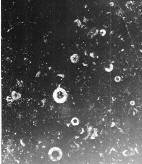
Although evidence from the Crown Point limestones suggest a local marine environment that was relatively quiet and shallow, the Ordovician itself was a tumultuous time in the geologic history of eastern North America (Figure 4). At the start of the period, roughly 500 million years ago, the land masses that now comprise the eastern margin of North America were separated by a wide ocean, called the Iapetus, and were located south of the equator. About 475 million years ago, the Crown Point limestones of Isle La Motte were being deposited as sediment at the bottom of an ocean that teemed with life. Towards the latter part of the Ordovician, perhaps 450 million years ago, a major island system in the Iapetus Ocean collided with the then eastern margin of North America, closing a portion of that ocean. The sediments of that portion of the ocean bottom were compressed, folded and thrust upward into what eventually became the Taconic Highlands, one of several northeastern mountain ranges formed during the Paleozoic era.
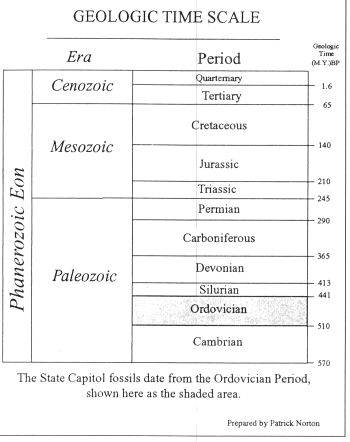
Where the heat and pressures were greatest, the ocean sediments were "cooked" into marbles, destroying any fossils that may have been present. Elsewhere, where the pressures were not so great, the sediments were compressed into limestones and the fossils were preserved. Gradually, over millions of years, the Taconic Highlands eroded and eventually exposed the old Ordovician marbles and limestones (Raymo and Raymo 1989). Those limestones were used by Spofford and Desmond in the floors of the State Capitol.
Unlike the stones installed by Desmond, which seem to contain only crinoidal remains, the stones installed by Spofford in the west wing contain a rich variety of fossils. Many of those fossils are fragmentary and have yet to be identified. Others, such as those described here, are more complete and are identifiable at various levels of classification. Unfortunately, all of the fossils in the State Capitol are seen only in cross-section with none of the 3-dimensional relief often necessary for identification at the species level. The floor stones have also been scratched, chipped and cracked from a century of heavy use and some of the fossils have been clouded by years of regular waxing and polishing. Despite those hazards, and the passage of 475 million years, remarkably beautiful details can still be observed in many of the fossils.
The coiled shell of the gastropod Maclurites can be seen throughout the west wing of the State Capitol. Gastropods, members of the Phylum Mollusca, were extremely abundant during the Ordovician and even today are second only to the insects in the number of living species. The shore periwinkle (Littorina littorea, L.) is probably the most recognizable gastropod found in Maine, but snails and their relatives are found almost everywhere in the world. Maclurites was a relatively large gastropod, with a shell diameter up to 15 centimeters and a flat bottom that allowed it to remain stable on the ocean floor. One interesting specimen in the State Capitol (Figure 5) is closely associated in the stone with an operculum, a calcareaou "lid" that, in life, would have been attached to the animal's foot and would have neatly sealed the shell opening when the foot was retracted.
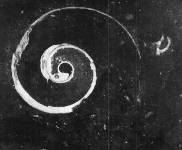
The Phylum Coelenterata, a group that includes corals, sea anemones and jellyfish, are represented by two forms in the State Capitol. A single beautifully preserved specimen of the rogose coral Lambeophyllum, relatively rare in the Crown Point formation, can be seen on the second floor of the west wing (Figure 6). Other stones in the west wing have captured pieces of the colonial coelenterate Stromatocerium (Figure 7). Colonies of Stromatocerium, which often appear as large, cabbage-shaped masses in the rocks, frequently grew to be more than a meter thick. The size of the floor stones, however, only allow us to see isolated sections of those impressive former colonies.
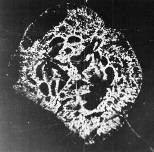 |
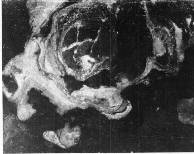 |
Crinoid stalk columnals can also be seen in the west wing. One stone in the west wing contains a longitudinal section of a crinoid stalk fragment that remained intact after the animal died (Figure 8). That specimen shows large and small columnals arranged along the stalk in a pattern of nodals and internodals common in may fossil crinoids. The small wedge-shaped projections from the stalk are branchlets, called cirri, which grew from each nodal. The canal that supplied nutrients to the living animal can also be seen running centrally down the length of the stalk fragment.
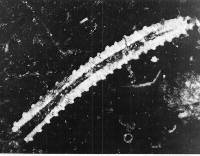
I classify two other specimens found in the west wing as belonging to the Phylum Bryozoa, or "moss animals." This classification is somewhat tentative since these specimens are each seen only once in the State Capitol and bryozoans from the Crown Point are generally not described as well as other phyla from that formation. The Crown Point, however, is one of a group of closely associated limestone formations in the Champlain Basin, and bryozoans from another of those formations have been described in more detail (Welby 1962). The small circular form seen on the third floor of the State Capitol (Figure 9) is very similar to the branching bryozoan Eridotrypa. A larger form, also on the third floor (Figure 10), shows the same general size, shape and internal organization as the biscuit-shaped bryozoan, Prasopora. Bryozoans are reported as abundant in the Crown Point, but useful descriptions of both Eridotrypa and Prasopora are found in surveys of a slightly more recent limestone formation of the Champlain Basin (Welby 1962).
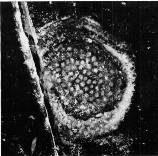 |
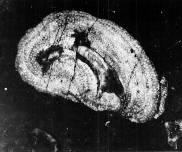 |
The creatures fossilized in the state Capitol limestones shared
the ancient lapetus Ocean with many others that may or may not
have been captured by the stone cutters working for Spofford and
Desmond. Ammonites and many species of trilobites lived during
that time, and have been preserved as fossils in the Crown Point
limestones, but have not yet been found in the State Capitol.
A more thorough survey of the State Capitol limestones is needed
and a closer examination of the beautifully detailed fragmental
remains would undoubtedly reveal the presence of additional phyla.
Many other types of creatures are almost certainly hiding somewhere
in the limestones of the State Capitol. Perhaps one is under an
old bench, or over in a dusty corner, waiting for the next curious
visitor to make another fossil discovery.